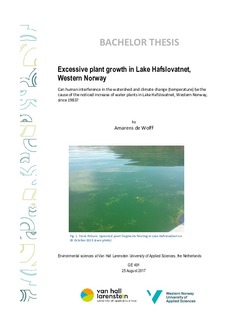| dc.description.abstract | Lake Hafslovatnet is part of a water system which lies in the county Sogn og Fjordane in Western Norway. At the base of this system lies the glacier Austerdalsbreen. Its meltwater passes, combined with normal precipitation, one river, one large lake and two small lakes before it passes Lake Hafslovatnet. This oligotrophic lake is the last location before the water flows into the fjords. Since the 1980s users of this lake noticed excessive growth of water plants in the lake, which began to interfere with recreational activities. There have been previous studies investigating the plant growth problem. Nonetheless the problem is still occurring to some extend nowadays. The purpose of this study was to analyse possible effects that could have caused the excessive plant growth that has been observed in Lake Hafslovatnet after the regulation of this lake and Lake Veitastrondvatnet in 1983. Therefore the following research question was formulated: Can human interference in the watershed and climate change (temperature) be the cause of the noticed increase of water plants in Lake Hafslovatnet, western Norway, since 1984?
The research was realized by gathering relevant information from literature combined with the analysis of hydrological, hydrographical and own data. The focus was laid on better understanding the role of the hydrology in the plant growth problem. With the literature research data was combined into a large dataset of hydrological and chemical parameters, which has not been done before. The data was statistically analysed with a Change point analysis and a (non) seasonal Mann-Kendall trend test.
With CTD measurements a better basic understanding of the present and recent hydrographic and hydrological structure of the lakes has been acquired. It shows that Lake Hafslovatnet has a two layered epilimnion when the lake is stratified. Furthermore it receives colder water at its inlet than at the outlet. Some small increasing trends in hydrological and chemical data were found: Turbidity, pH and iron. Yearly summarized air temperatures had two detected increasing trends for to low altitude stations (Lærdal and Fjærland). One increasing trend was found with a seasonal Mann-Kendall trend test on monthly averaged values. The yearly summarized water temperature had an increasing trend, and the separate tested months resulted in April and October both having an increasing trend. Two changes were similar for air as for water temperatures (1997/1998 and 1993 / 1992).Between the 1960’s and ca 1990 the most alterations in the water system were made. The scattered data did not show clear connections to certain dates, but indicated some changed conditions in the system. The analysis revealed some different factors that were involved. These factors could be local (altering the two rivers Storelvi and Heggestadelvi, building a bypass tunnel, hydroelectric power plant) and global (regulation, changes in air or water temperature, beach erosion, changes in hydrological or chemical parameters etc).
With this investigation it is clear that there could be many more factors involved in the plant growth problem compared to the factors discussed in previous papers. One of these factors could be related to the bypass tunnel built for the regulation. A second factor could be beach erosion, taking place at Lake Veitastrondvatnet, Lake Tverrbergvatnet and Lake Straumane. To verify both factors, additional research is needed. Finally it is important to keep measuring to maintain the long term datasets. | nb_NO |

